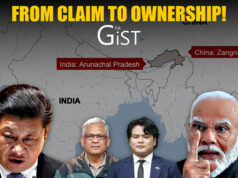The political upheaval in Bangladesh since the 2024 student‑led “monsoon revolution,” which ended Prime Minister Sheikh Hasina’s 15‑year tenure, has pushed bilateral ties with India to their most precarious point in over a decade.
Nobel Laureate Prof. Muhammad Yunus now leads an interim government, but instability has halted what, for years, had been one of South Asia’s most successful connectivity partnerships. In a report published by the Centre for Social and Economic Progress (CSEP) titled “What Future for India–Bangladesh Connectivity?”, Sushovan Chakraborty and Riya Sinha warn that nearly every major road, rail, energy, and digital link has been disrupted.
With elections due in early 2026, India faces a stark choice: safeguard hard‑won gains or cede space to regional rivals, most notably China.
The CSEP study details how flagship projects like the Agartala–Akhaura and Khulna Mongla rail links have been mothballed mere months after their inauguration. Passenger train services have ceased, digital integration plans are on ice, and the India–Bangladesh Friendship Pipeline (IBFP), designed to supply diesel to northern Bangladesh, has been idled.
India’s suspension of land‑route transshipment rights has particularly hurt Bangladesh’s garment sector, wiping $770 million—42% of bilateral trade—off the books. Dhaka, as noted in the CSEP report, responded with import restrictions, new transit fees, and tighter customs checks. The result: businesses on both sides face rising costs, falling profits, and deepening mistrust.
Bilateral tensions intensified when India offered refuge to the ousted Hasina. Dhaka’s rhetoric shifted—from portraying Bangladesh as a partner in regional integration to framing itself as the “gateway to the ocean” for India’s “landlocked” Northeast.
The power shift was unmistakable in June 2025, when Bangladesh hosted a trilateral summit with China and Pakistan. Beijing has since moved aggressively: reviving an air base near the Indian border, wooing Bangladeshi medical tourists (a market India once dominated), and reportedly eyeing Indian‑supported port developments. Without a course correction, the strategic space India built painstakingly over the last decade could narrow rapidly.
Building on the CSEP report’s recommendations, there are pragmatic ways for New Delhi to limit further losses and rebuild trust during Dhaka’s political transition:
- Low‑visibility, high‑impact cooperation – As the CSEP authors note, smaller, economically vital projects are less politically vulnerable. Quietly reviving the Friendship Pipeline, resuming freight rail, and expanding tripartite energy projects with Nepal and Bhutan could deliver tangible results without triggering controversy.
- Work with trusted partners – Japan’s infrastructure track record in Bangladesh, from Matarbari port to the Joydebpur–Ishurdi railway upgrade, shows the value of triangular partnerships. Co‑branding with trusted countries reduces risks that the CSEP paper warns can derail bilateral projects.
- Invest in people‑to‑people links—the CSEP study emphasises the resilience of grassroots engagement. Initiatives like border haats, scholarships, skill‑building workshops, and heritage conservation projects, such as Satyajit Ray’s ancestral home, can maintain goodwill despite political headwinds.
- Use subnational diplomacy—border states share cultural and linguistic ties with Bangladesh that central governments can’t replicate. The CSEP report points to paradiplomacy as a way to maintain trade, tourism, and cooperation on disaster management even when Delhi–Dhaka ties are strained.
India’s strategic calculus rests on more than economics—it’s about securing Northeast India’s access to the sea, insulating trade corridors from external dependence, and balancing China’s growing influence. But as the CSEP report underlines, connectivity is as much about mutual trust as concrete and steel. You can rebuild railways; rebuilding confidence is harder.
The months leading up to Bangladesh’s 2026 elections are a critical preparation period. Meaningful progress won’t come through high‑profile announcements, but through patient, behind‑the‑scenes work so India is ready to move when political stability returns to Dhaka.
If New Delhi can heed the tactical caution and strategic urgency in the CSEP study by Chakraborty and Sinha, it might yet revive the “golden chapter” of India–Bangladesh connectivity. If not, it risks watching China write the next one.
In a career spanning three decades and counting, Ramananda (Ram to his friends) has been the foreign editor of The Telegraph, Outlook Magazine and the New Indian Express. He helped set up rediff.com’s editorial operations in San Jose and New York, helmed sify.com, and was the founder editor of India.com.
His work has featured in national and international publications like the Al Jazeera Centre for Studies, Global Times and Ashahi Shimbun. But his one constant over all these years, he says, has been the attempt to understand rising India’s place in the world.
He can rustle up a mean salad, his oil-less pepper chicken is to die for, and all it takes is some beer and rhythm and blues to rock his soul.
Talk to him about foreign and strategic affairs, media, South Asia, China, and of course India.





